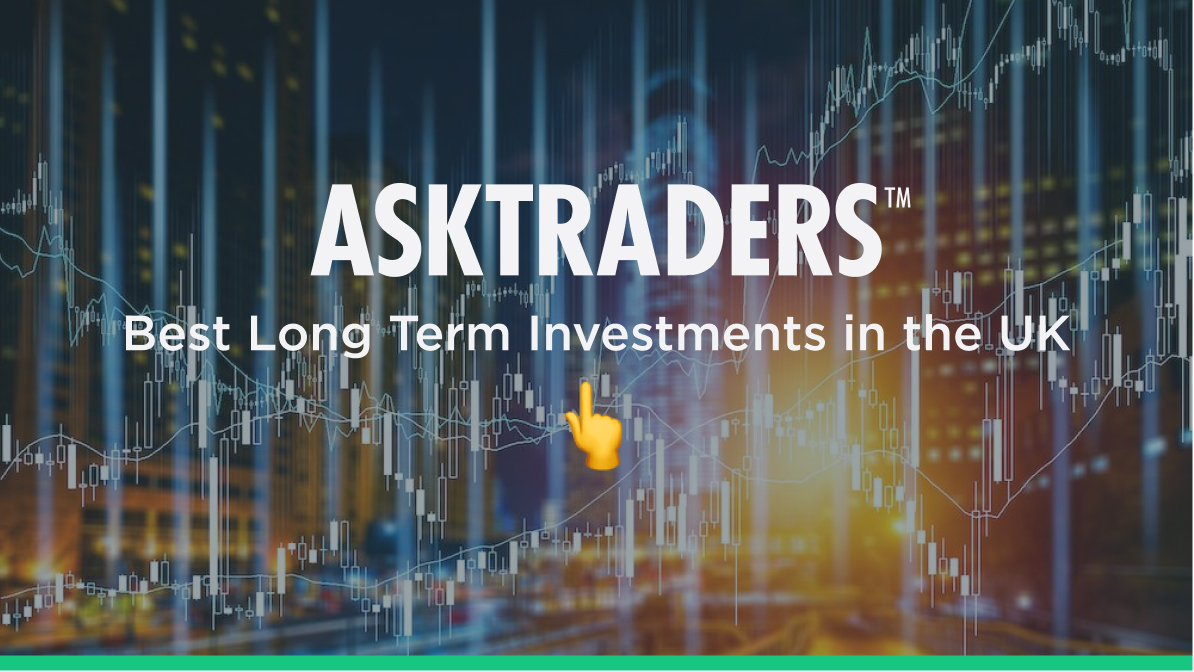Investing for the long term has many advantages. Holding onto positions can allow enough time for your strategy to come good. If you’ve spotted a trend and backed it, there may be a lag before the rest of the market draws the same conclusions.

YOUR CAPITAL IS AT RISK
For UK residents, navigating the plethora of investment options can be a daunting task. However, understanding the nuances of each investment is crucial for making informed decisions.
Table of contents
FTSE 100 ETF
The FTSE 100 is the index of the largest 100 companies listed in the UK. The largest firm in the index is oil and gas giant Shell Plc (LON: SHEL), and the firm with the smallest market capitalisation is Hargreaves Lansdown Plc (LON: HL.).
If you invest in the FTSE 100, you are investing in blue-chip stocks that have established business operations and the critical mass to generate long-term profits.
| Pros | Cons |
|---|---|
| If one of the firms suffers a change of fortune and becomes less attractive to investors, its market cap will fall, and it will be ejected from the index. | The FTSE 100 index tracks the performance of the 100 largest companies listed on the London Stock Exchange, meaning your investment is heavily concentrated in the UK stock market, which could make your portfolio more vulnerable to risks specific to the UK economy. |
| The reorganisation is managed by the fund manager, so you don’t need to do anything to cut your losses on the position. | The FTSE 100 index is overweight in certain sectors, such as financials, materials, and energy. As a result, your investment is more exposed to the performance of these sectors. |
| If a new up-and-coming firm qualifies, it will enter the FTSE 100 and become part of your portfolio. | |
| FTSE 100 ETFs typically have lower fees than actively managed funds, making them a more cost-effective investment option. |
How to Invest
The iShares Core FTSE 100 ETF (ISF.L) is available at eToro and other brokers and offers traders the chance to take a position in the top 100 UK companies with the click of a button. As a passive tracker fund, it is also a cost-effective way to invest. The Total Expense Ratio (TER) of 0.07% means that for every £1,000 invested, the annual management fee will be just £0.70.
Anglo American PLC (LON: AAL)
The beauty of ETF funds is that they mitigate single stock risk, but if you’re looking to introduce greater risk-return into your long-term strategy, mining giant Anglo American fits the bill. The firm operates globally and is a major player in the platinum, diamond, copper, coal and iron markets.
| Pros | Cons |
|---|---|
| Mining stocks such as AAL look set to benefit from the move to a lower-carbon global economy. | Commodity markets are notoriously cyclical because demand for their products is a function of the health of the broader global economy. |
| Building the infrastructure required to support new, greener alternatives such as EVs will need vast amounts of raw materials, which could result in a ‘commodities super-cycle’ forming. | It can take years for new mines to come online. However, the supply-side lag means a burst of economic growth drives up the prices of commodities. |
| Booms in the commodity markets can last for decades, and many analysts think we’re due one, as the last one was seen in the early 2000s. | |
| Anglo American’s stock is an ideal pick for a long-term investment portfolio with a weighting toward higher risk-return. |
How to Invest
Various online brokerages will allow you to buy shares of AAL. Make sure to check the assets available to buy on the brokerage account before you sign up.
Property Funds
Property funds are a type of investment that gives individuals exposure to the real estate market without having to directly purchase and manage properties themselves. The funds pool money from multiple investors and use it to invest in real estate assets.
| Pros | Cons |
|---|---|
| Real estate investments have traditionally generated healthy long-term returns for investors. | The main problem with property investments is that they can be very illiquid, so getting your money back quickly can be difficult. Property is, therefore, an ideal asset group for long-term rather than short-term investors. |
| Property funds can provide investors with diversification benefits by adding a different asset class to their portfolios. | Buying property outright can also be expensive in terms of transaction and administration costs. |
| Property funds can provide investors with access to a wider range of properties and property types. | |
| Property funds can generate income from rent payments and capital appreciation. This can provide investors with a steady stream of income. |
How to Invest
One way of investing in a property find is via the Real Estate Select Sector SPDR Fund ETF (XLRE), which includes securities of companies from the following industries: real estate management and development and REITs, excluding mortgage REITs.
The stocks bought are those of large-cap blue-chip companies, and with 34 different holdings, it offers exposure to varying areas of the property sector. Because the Real Estate Select Sector ETF gains exposure to the sector by buying the stocks of property firms, the TER is only 0.10%. To invest in the fund, you will need to find an online stock brokerage that offers it on its platform.
Dividend Stocks
Dividend stocks, as you may already know, are companies that pay out dividends (a share of their profits) to investors. Dividend stocks are considered relatively conservative investments.
| Pros | Cons |
|---|---|
| Investing in high-yield dividend stocks can be a good source of steady long-term returns. | High-yield stocks are sometimes considered low growth as they are returning cash to investors rather than investing in exciting new projects. |
| Dividend stocks can also be an excellent counterbalance to some riskier positions in your long-term portfolio. | |
| Dividend stocks are ideal for long-term investors. |
How to Invest
Various online stock brokerages will offer investors the ability to buy shares of different dividend stocks. When choosing a broker, make sure they are appropriately regulated and let you invest in the dividend stock(s) you require.
An alternative approach is buying an ETF such as iShares Core High Dividend ETF, which includes 75 dividend-paying stocks screened for financial health.
Government Bonds
Government bonds are debt securities issued by a government to finance its operations, including infrastructure projects, social programs, and defence spending. Government bonds are generally seen as low-risk investments as they are backed by the issuing government. However, that does not mean they are entirely safe, with many countries in the past defaulting or facing a debt crisis.
| Pros | Cons |
|---|---|
| Compared to stocks or corporate bonds, government bonds are generally considered a lower-risk option. | The main potential risk is that the government which issued the bonds defaults on the deal. |
| The returns are fixed and set by the issuer, such as the UK government. | |
| It’s possible to make returns greater than those offered by holding cash in savings accounts. | |
| The predictability of bonds can help investors plan. |
How to Invest
Traditional investment advice is that long-term investors should hold a percentage of their total capital in bonds. The security they offer helps with planning and also facilitates spare capital being allocated to riskier investments. It’s possible to buy bonds directly from the government Debt Management Office or by using an ETF fund. The iShares 20 + Yr Treasury Bond ETF (TLT) takes positions in a variety of long-dated US bonds and has a TER of 0.15%.
What to Consider When Investing For the Long-Term
Know Your Investment Aims
Establishing your risk appetite and timeline horizon is vital as long-term investing can be a rollercoaster ride, and you’ll want your portfolio to mature at a specific date.
Designing a strategy that factors in your attitude to risk also goes some way to taking the emotion out of the situation and avoiding the chance of making panic decisions.
Have a Clear Strategy
All investing should be based on using funds you can afford to lose. Whatever the assets involved, effective portfolio management includes having a well-thought-out plan.
Assess the Costs
If you’re holding an asset as a long-term investment, it’s essential to check the T&Cs and determine the administrative costs applied.
If you’re holding your position for several years, costs can add up, and as CFDs can be particularly expensive, long-term investors must avoid using them by mistake.
Another potential cost to look out for is account inactivity fees. These vary from broker to broker but are definitely something to be aware of.
Consider Using Tax-Efficient Investment Methods
Investing over the long term can benefit from certain tax breaks.
Pension funds, SIPPs, and ISAs all come with some degree of preferential treatment. For example, ISAs (Investment Savings Accounts) are a popular option for those in the UK. There are various aspects to consider to take advantage of tax-free investing.
Monitor Your Long-Term Investment
One of the advantages of long-term investing is that it can be relatively hands-off. In fact, not tinkering with a position and sticking with your strategy is recommended.
However, things can change. If an unexpected event changes the basis of your strategy, then be prepared to reassess.









